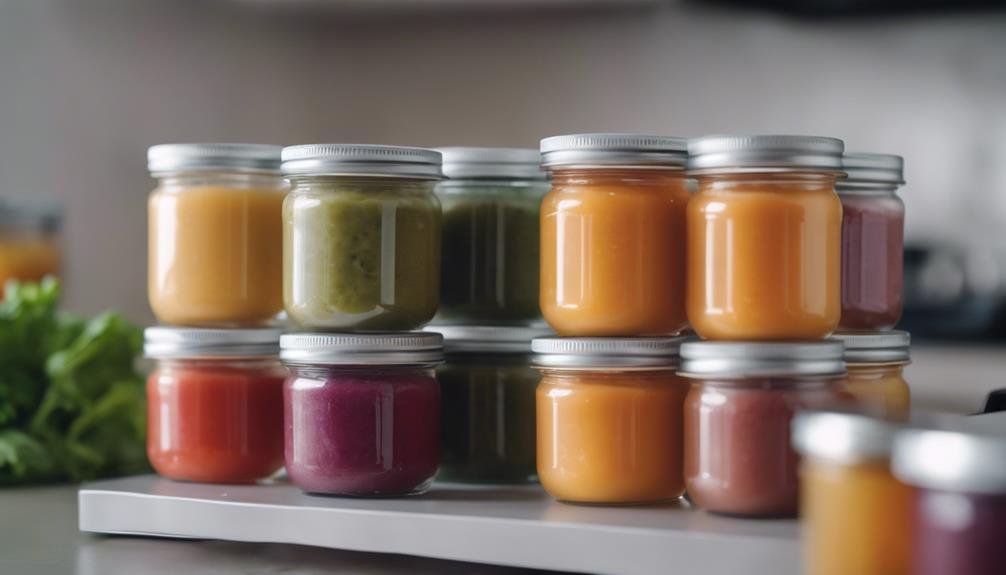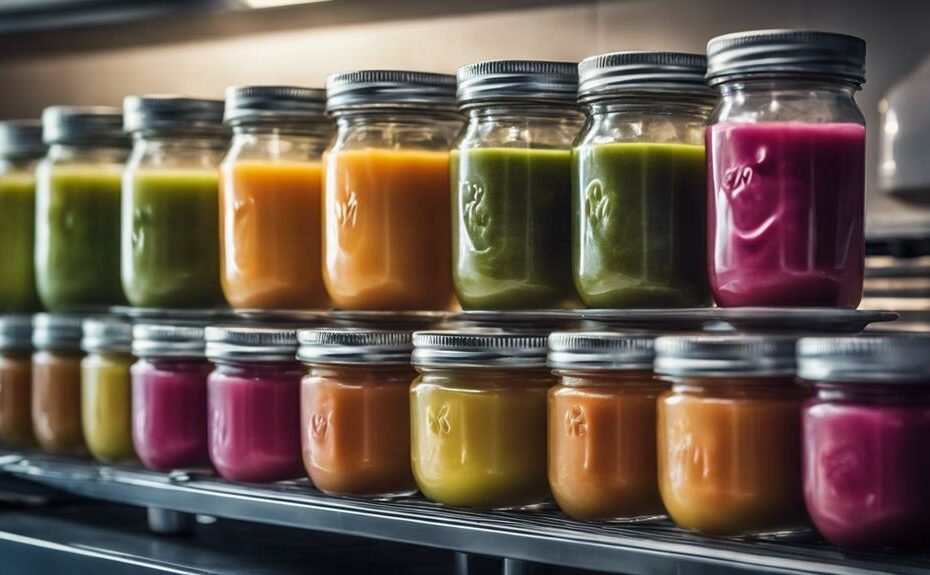Vacuum sealing is an excellent way to safely preserve homemade baby food. You'll guarantee shelf life, retain nutrients, and prevent spoilage. Choose a vacuum sealer with adjustable suction levels and food-safe features. Use BPA-free, stackable containers with leak-proof seals for easy storage. Clean and dry containers thoroughly before sealing, and label them with dates for easy tracking. When thawing, use the refrigerator method for safety. Always inspect seals before use and store containers in a cool, dry place. By following proper techniques, you'll secure your baby's food stays fresh and nutritious. Discover more ways to optimize your baby food preservation process.
Benefits of Vacuum Sealing Baby Food
With vacuum sealing, you'll preserve your baby's food more effectively while retaining its nutritional value and extending its shelf life. This method offers numerous benefits that guarantee your little one's meals remain fresh, nutritious, and safe for consumption.
One of the primary advantages of vacuum sealing is nutrient retention. By removing oxygen from the container, you're preventing oxidation, which can degrade essential vitamins and nutrients in the food. This means your baby will receive the full nutritional benefits of their meals, even after storage.
Vacuum sealing also greatly extends the shelf life of baby food. The absence of air slows down spoilage, allowing you to store homemade meals for longer periods without compromising quality. This is particularly useful for busy parents who prefer to prepare meals in advance.
Food safety is another important benefit. Vacuum-sealed containers create an environment that inhibits the growth of harmful microorganisms, reducing the risk of contamination. Additionally, this method helps maintain the food's original flavor and texture, ensuring your baby enjoys their meals just as you intended.
Lastly, vacuum sealing offers convenient portioning and storage options. You can easily divide meals into appropriate serving sizes, making it simple to grab and go when needed.
Choosing the Right Vacuum Sealer
Now that you're aware of the benefits, let's focus on selecting the ideal vacuum sealer for your baby food preservation needs. When choosing a vacuum sealer, consider its size and capacity to make sure it can handle your desired portion sizes. Look for models with adjustable suction levels to prevent crushing delicate foods while still creating an airtight seal that maintains nutritional value.
Opt for a food-safe vacuum sealer with durable construction and user-friendly features. Automatic sealing functions and compatibility with various container sizes can make the process more convenient. Check for airtight sealing capabilities to guarantee your baby's food stays fresh and nutritious.
To help you visualize the ideal vacuum sealer for baby food preservation, consider these features:
- A compact design that fits easily on your kitchen counter
- Clear, intuitive controls for adjusting suction levels and sealing times
- A wide sealing strip to accommodate different bag sizes and shapes
Step-by-Step Vacuum Sealing Process

You'll find that vacuum sealing baby food is a vital process that's easy to master with a bit of practice.
To begin, make sure your container is spotlessly clean and dry before adding the food item. This step is essential for preserving freshness and preventing contamination.
Once you've filled the container with baby food, securely place the lid on top.
The vacuum sealing process involves using a pump to remove air from the container through a valve in the lid. Simply pump around this valve until you've extracted as much air as possible. This removal of oxygen is key to extending the shelf-life of the baby food and maintaining its nutritional value.
When it's time to access the stored food, you'll need to release the vacuum seal. This is done by pressing the valve, which allows air to re-enter the container.
The ease of opening and resealing makes vacuum-sealed containers a convenient choice for busy parents.
Best Containers for Vacuum Sealing
When it comes to vacuum sealing baby food, selecting the right container is essential for maintaining freshness and ensuring proper storage. You'll want to choose containers specifically designed for vacuum sealing to retain essential nutrients and flavors while keeping your little one's food safe.
Opt for stackable containers that allow for efficient organization in your fridge or freezer. These containers are typically made of durable, food-grade plastic that's BPA-free and dishwasher safe. By using vacuum seal containers instead of traditional plastic bags, you'll reduce food waste and maintain the quality of food for longer periods.
Here are some key features to look for in vacuum seal containers for baby food:
- Transparent lids for easy identification of contents
- Measurement markings on the sides for portion control
- Leak-proof seals to prevent spills and contamination
Storage and Thawing Guidelines

Once you've chosen the right containers, it's important to follow proper storage and thawing guidelines to make sure your baby's food stays safe and nutritious.
When using vacuum-sealed containers, always label them with dates to keep track of storage time and maintain top quality. Rotate your stored baby food, using older portions first to maintain a consistent supply of freshly prepared meals.
When it's time to use the frozen baby food, remember that proper thawing is essential. Always thaw frozen baby food in the refrigerator for gradual and safe defrosting. This method helps preserve nutrients and reduces the risk of food spoilage.
Avoid microwaving vacuum-sealed containers directly, as this can lead to overheating or uneven heating, which may compromise the food's safety and nutritional value.
Safety Precautions and Considerations
While vacuum sealing offers numerous benefits for preserving baby food, it's critical to prioritize safety precautions and considerations throughout the process. Always guarantee proper sealing of vacuum containers to maintain freshness and prevent contamination.
Regularly inspect your containers and seals for any damage or cracks that could compromise the vacuum sealing process and lead to food spoilage.
When it comes to storage precautions, keep vacuum-sealed containers out of children's reach to prevent accidental opening or misuse. Avoid exposing the containers to extreme temperature changes, as this can affect food quality and safety. Remember, food safety is paramount when dealing with baby food, so never use containers with cracked seals.
To help you visualize proper vacuum sealing practices, consider these key points:
- Inspect seals before each use, looking for any signs of wear or damage
- Store containers in a cool, dry place away from direct sunlight
- Label containers with contents and date for easy tracking
Conclusion
You've now got the tools to safely preserve your baby's food like a time capsule of nutrition. By vacuum sealing, you'll extend shelf life, maintain quality, and save time.
Remember to choose the right equipment, follow proper sealing techniques, and adhere to storage guidelines. Always prioritize safety and cleanliness when handling your little one's meals.
With these tips, you're well-equipped to provide fresh, homemade goodness for your baby, even on the busiest days.
